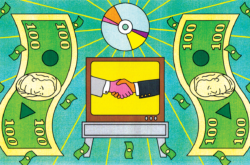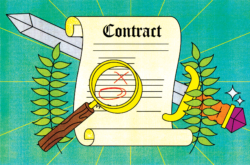Illustration: Daniel Zender
The music industry has long-deserted its days of prescriptive methods for the success of artists.
It’s not so difficult to imagine, as early development of audio recording technology was picking up steam in the mid-late 19th century, a world in which there were very limited pathways to a sustainable career as a musician. I write jingles, I perform live, I score orchestral music, and so on—these were straightforward, specialized paths to make a living as a musician, laid at the feet of those willing to give it their all.
Nothing about this observation is profound. Rather, it relates to the experience of a broad range of careers continuously recast by technology, with entertainment being no exception. In today’s industry, the reality is that independent and emerging artists are often forced to have their hands in all possible revenue streams in order to pay the bills. Pure specialization, this observation might suggest, isn’t enough to quit the day job for good.
Before we become too pessimistic, the emergence of new revenue streams for audio producers such as podcasting and gaming are truly incredible opportunities for new forms of specialization. The problem is more so that it has become harder and harder to be a self-sustaining creative without operating as a jack of all trades. So let’s adapt, and do so while protecting the time and space of your creative self.
In this article, we’ll be hyper-focusing on one method of revenue stream diversification that’s often intimidating, underrated, and just downright confusing. This piece will aim to build off of our previous exploration of sync licensing to debunk some misconceptions and hear from the experts so you can prepare yourself, and your library, to be sync-ready.
The licensing types for sync placements
Entertainment and other forms of mass media require audiovisual components that usually can’t be written by the average Mad Men character. Whether it’s a straightforward insurance commercial, the intro to a television series, or a digital poker machine, music is almost always involved. To identify and secure this music, there are two popular licensing types to be aware of: original music and library music.
1. Original music
The former is written custom to spec, and can seek an exclusive composition license for a set or indefinite period of time, and often requires feedback rounds with quick turnaround times. That’s assuming your music is selected, given the pitching process is often structured as a no-guarantee bidding war between other collectives or companies which specialize in such work.
For some, this high-pressure work could easily be an imposition against other creative projects. Others may thrive under such pressure and utilize the opportunity to compose across a wider range of genres and influences.
2. Library (stock) music
Most producers who approach sync licensing as a passive source of income will do so via library music. Also referred to as stock music, it allows for a more ‘set-it-and-forget-it’ approach. Companies such as Epidemic Sound and Artlist are among the many organizations who have established themselves as prominent players in this space, touting tunes across a wide range of price points. Our experts, who we’ll share more from below, also recommended artists look into Extreme Music, Sonixphere, Audiomachine, 5 Alarm Music, West One Music, and MPath.
These libraries can notably act as an opportunity for independent artists to place sonic content which may have been left on the cutting room floor. Think of it as dead stock fashion for your music; a track that’s unfinished or off-brand to a producer could be exactly what a brand needs for their own vision to come alive. With license duration generally set (and priced accordingly) in collaboration between the artist and company, this can lead to a payout for something that’s otherwise an annoyance on your hard drive.
Despite this intimidating breadth of commercial opportunities, and whether such ventures provide one-time payouts or passive revenue, the right combination can unlock career longevity, alleviate financial stress, and provide an injection of funding for your future projects.
Knowing what’s right for you
Let’s get it out of the way: finding sync placements isn’t the revenue stream for everyone. We can notice a historical narrative and correlation between licenses for the purpose of advertising and artists deemed as ‘selling out.’ As sync licensing opportunities have broadened and new generations have taken the spotlight, however, we’ve seen less of a blanket approach. With plummeting income from physical music sales, and as companies across all industries are held more accountable, artists have found more leverage in their decision of who to work with, or perhaps more fittingly stated, to stand with.
Therefore, when considering exploring the world of sync placements, it’s crucial to consider what, if any, dealbreakers you have. What would you say no to, and why? What or who would be your ideal partners in aligning with your brand, values, and creative style?
What the experts say on sync placements
Senior Music Producer Tim Shrout was one individual who shared his experience with us in preparing for this article. He emphasized a few shared qualities of artists who’ve found the most success with sync placements in his work at Marmoset Music: continuous output, versatility, and a shift in focus from artistry to craft.
And this is exactly where we yet again distinguish between offering up your existing compositions for sync and writing to spec. Tim emphasizes the unique skill shared by successful artists in sync of “using deep musical skills and knowledge to create something aimed at a specific goal or filling a certain creative need, rather than pure expression. Taking feedback and making changes to a piece that’s intended for licensing purposes is essential to success, and doing so with minimal attachment means they’re more likely to end up with something that other creatives will want to pay for.”
Esin Aydingoz, Assistant Chair of the Screen Scoring Department at Berklee College of Music, also emphasized a key decision for artists here. She shares, “Writing music under your own name vs. being a composer’s assistant or an ‘additional music’ writer are different career paths. One can of course balance both if they want.”
Dom Jones, TV & Film Music Specialist at Sony Music Group, emphasized the importance of patience, consistency, and openness to feedback without losing artistic integrity. She also shares, “The biggest misconception, in my opinion, is that music supervisors simply make playlists of their favorite songs and that they are the one and only decision maker in the process of placing music. Directors, producers, studio executives and showrunners all have input into the music for a project alongside a music supervisor. There are so many reasons why a song may or may not make the final cut of a film, television show, ad, or video game. It’s not just about liking a song; it’s about the ability to complete the business and legal process of gaining permission to use that song.”
Repurposing existing music for licensing can be a more immediate option for producers, though the lift highlighted by Jones can vary depending on your catalog and perhaps how many writers are credited. Attendees at the 2022 Most Wanted: Music conference in Berlin were given an inside look at this via a panel entitled “How to Pitch to a Supervisor: Do’s and Don’ts.” Here, The Elements Music‘s Nick Maker, Vice Media Group‘s Jackie Palazzolo, and CINESONG‘s Milena Fessmann were put on the spot with track submissions from conference attendees.
A common statement, first shared by Milena, was “this track is absolutely syncable.” Much how university students are drilled with cautionary words of how quickly their resume will be judged by hiring managers, this tenured leader in film sync needed only a few seconds to gauge viability of this artists’ work for her current and future projects.
How to reach out to music supervisors (and other channels)
The group also shared a few overall tips for reaching out to individual music supervisors, or submitting your music through other channels such as that mentioned in the next section. Here’s what they shared:
- Don’t expect anyone to review a link requiring a download. Whether you’re sharing a new release or a broadened EPK, make sure that it’s streamable and easy to review.
- Be ready with different track versions that may be needed. Jones also brought this up in our conversation, emphasizing “instrumentals, acapellas, a TV mix, and if there’s profanity, a clean mix.”
- A high number of music supervisors utilize DISCO, where info such as lyrics can be easily added to tracks for preview, and many film composers pitch their original work via Reelcrafter.
- Research the projects that individual (and the companies they represent) has worked on in the past. If you can find specific clients they work with, look up previous advertisements by that brand, episodes of that series, etc. and play your music with the content on mute. A specific mention of where you see brand alignment can go a long way in distinguishing yourself amidst a high volume of emails just like yours.
- Clearly state if your submission is one-stop. For more on one-stop and other common terms used by music supervisors, check out this piece.
- A no is not always a no. Despite hundreds of cold emails coming in per week, the panelists emphasized their pride in giving every one of them their fair shot, so long as they can review it efficiently via the recommendations above. It’s not unusual for these individuals to hear a track and come back to it, if a new creative brief comes in down the line that could work with your music. Following up can be tastefully done, but also easily overdone.
Shrout has also noticed the average payout for limited-time licenses hovering between $1,000 – $2,000 USD, though the total range is quite wide depending on the client. That’s the kind of passive income that can reframe “selling out” to “bills paid” and provide time and resources for further career growth.
A common thread here is that the landscape is constantly changing. Maker shared that he’s “noticed a significant increase in requests from music not from sync,” or rephrased, from “‘regular’ artists.” Later in the panel, Palazzolo observed that social media payouts to artists, and overall budgets, have at last caught up to that which we’ve historically seen for television spots.
While social media platforms such as TikTok have much work to do in order to provide artists with adequate compensation for organic, user-generated sync, this is a massive transition alongside the overall diversification of sync opportunities which we’ve touched on throughout this piece. We are witnessing a shrinking barrier of entry for artists who may not see themselves as a commercial artist, but can now more realistically benefit from the sustainability which such markets may provide.
Representation, or no representation?
Shrout, when asked about common misconceptions in this field, immediately shared, “The biggest [misconception] I’ve seen is that getting representation will lead to guaranteed income in the immediate future. Yes, some artists have big catalogs that are primed for sync placements, but the average artist who’s made a record and finds a library or agent to rep it isn’t going to immediately be able to quit their day job. For the majority of the artists we work with, sync revenue is just one piece of many in their revenue pie.”
Still, finding representation from a company that you align with and trust to get your music in front of the right ears could very well be worth the ~20% cut they’ll take. Jones certainly agrees, sharing, “There are times when an artist can build direct relationships with music supervisors, but more often, a supervisor will reach out to a reputable sync agency as a trusted source for music, knowing that said agency will understand and have the ability to complete the business process of licensing music in a timely fashion.”
If you can’t find an agency you align with right now, or just want to begin by building direct relationships, building a LinkedIn network will only help you in the long run. It’s true that many performing artists don’t have as much of a need for this platform, but the business folks do, and approaching select individuals with a strategic message can help forge those initial connections.
In addition, building a list of companies you’d like to submit to regularly via official channels can help you gradually build a name for yourself without signing with a partner company or relying on individual pitches. Companies like Marmoset, however, only open their submission page “periodically” as to maintain a manageable number of inquiries—another reason for our interviewees’ recommendation to ultimately find representation.
Conclusion: How to use sync placements as a revenue stream in music
We’d love to hear your story. What companies do you respect the most or aspire to work with? What has your experience been, whether following or undertaking a different approach to something we’ve shared? If you have any tools for sync placements to share, or requests for us to explore further rabbit holes, please share your thoughts with us on Discord, so we can help you and your fellow artists to create more sustainable careers doing what you love.
To close with one last piece of wisdom from Dom Jones, remember that “nobody can beat you at being you, so lean into what you have to offer.”
P.S. For the expanded interviews with Dom Jones and Tim Shrout, feel free to explore here. A special thank you to Esin for her feedback and resulting contributions to this piece.
To connect with the panelists at Most Wanted: Music, feel free to reach out via LinkedIn to Nick, Jackie, and Milena, and don’t forget—streamable links only!
Explore royalty-free sounds from leading artists, producers, and sound designers:
January 10, 2023



